The Apple Thunderbolt Display Review
by Anand Lal Shimpi on September 23, 2011 2:56 AM EST- Posted in
- Displays
- Mac
- Apple
- Thunderbolt
- Thunderbolt Display
Brightness and Contrast
For brightness, black level, and contrast points, we use the same colorimeter setup described earlier. Specifically, we use an Xrite i1D2 with ColorEyes Display Pro, and take measurements at maximum and minimum brightness of white and black targets. Dynamic contrast is turned off. We also let the panels settle in for a half hour at the respective settings before taking any measurements.
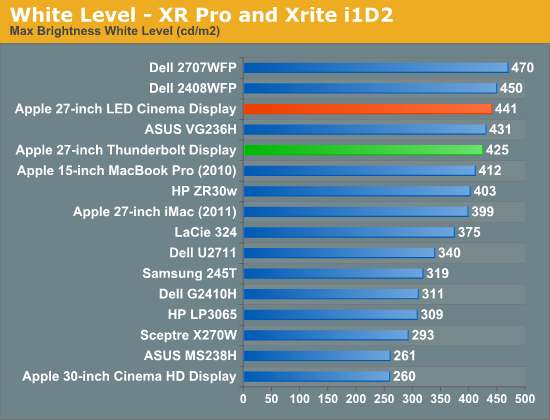
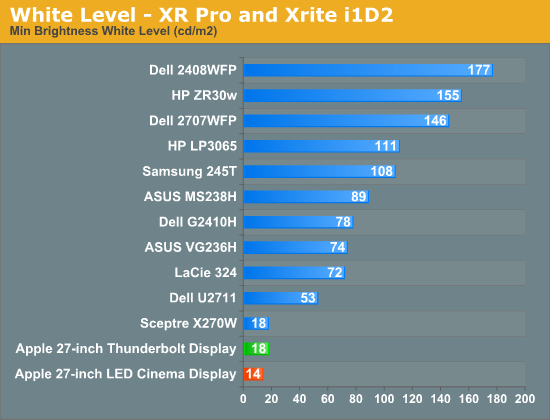
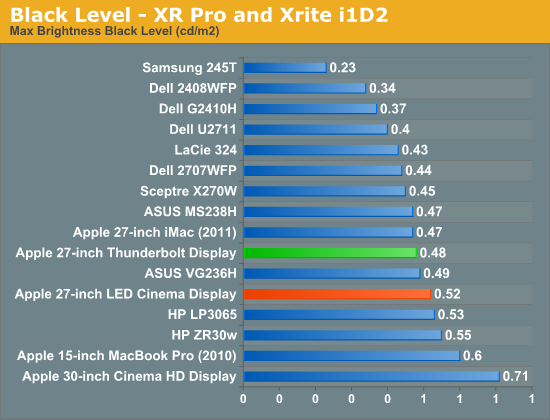
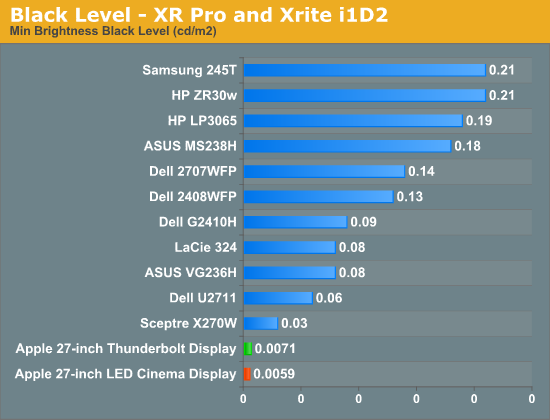
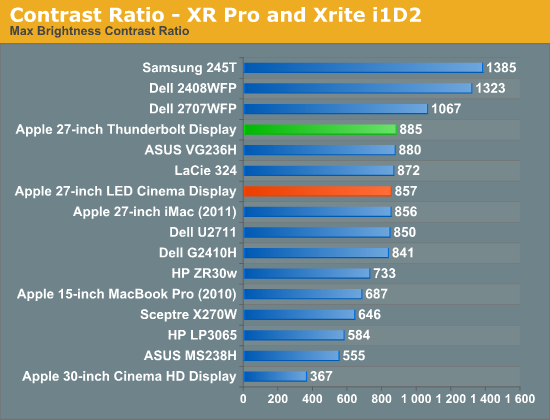
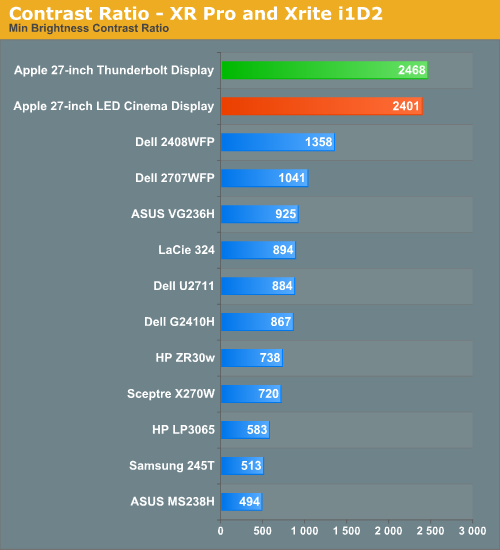
If you were expecting an change in panel quality you won't find it here. The Thunderbolt Display is almost exactly the same as last year's panel but with a bunch of new features.
Brightness Uniformity
In addition to the performance at center, we’ve also added 9-point testing for brightness, both white and black. This is done the same way we measure color uniformity, except we only care about measured intensity. We set the monitor to near 200 nits, and then measure those 9 points.
The Thunderbolt Display performed very well in these tests. The display was very consistent everywhere. Although the center of the panel measured about 8% brighter than the surroundings, it wasn't noticeable in actual use. Brightness uniformity was remarkably consistent through the majority of our measurements, even better than the original 27 we reviewed last year.
White Level Uniformity


Black Level Uniformity

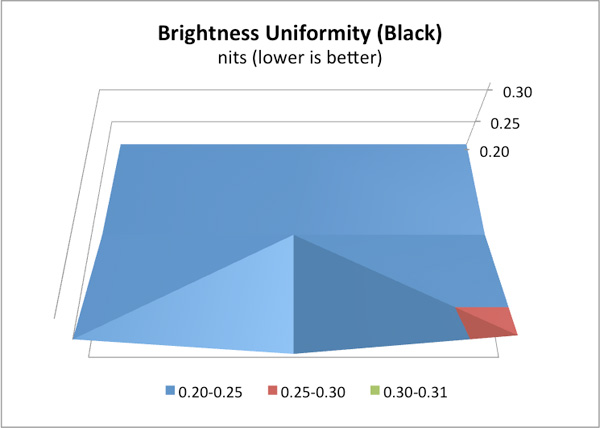
Viewing Angles
The Thunderbolt Display uses an IPS panel which guarantees good horizontal and vertical viewing angles. It doesn't matter how you tilt the display or from what angle you're looking at it (within reason), you'll get a fairly consistent image.















275 Comments
View All Comments
doubledeej - Sunday, September 25, 2011 - link
I have many friends that work in "broadcast" and all but one of them lust after the Apple displays because they've got this silly notion that they are the best out there. No matter how many charts, spec sheets, reviews, etc., I throw at them, they refuse to believe that a Dell, Eizo, or anybody else could produce a monitor that performs better, especially if said monitor happens to be less expensive. There are an awful lot of Apple Kool-Aid drinkers out there, and nowhere is it worse than with video "professionals."seapeople - Friday, September 23, 2011 - link
My new Dell XPS 17 has an antiglare screen. Moderate progress?Dennis Travis - Friday, September 23, 2011 - link
Excellent review Anand as always. You covered everything I was curious about and more. Thanks again!HHCosmin - Friday, September 23, 2011 - link
want to say i just love your reviews Anand. i can tell you are passionate about what you do.this thing seems quite cool and it brings lots of help in cable clutter area. however i'm a pc guy and this is a mac. you talk about the future, and the possibilities. i've been thinking about this for some time now and getting really excited about the implications. i can see getting standard having monitors with thunderbolt and not much else to keep price down. link the display (through thunderbolt) cases that have sata ports and pciexpress ones. i call this a "slave box".
to have:
- laptop: slim, light, good autonomy (should be able to power this via display)
- display with thunderbolt, with ability to extend and not much extra
- a "slave-box" having psu, hdds, gpus and pciexpress slots for extras (no memory or cpu)
you get:
- use (and pay for) a single machine that you can carry around (with igp only)
- have practically no cable clutter
- get to feed power to the laptop through the monitor (when/if laptop maker standardize mobile bricks)
- have extra gpu/storage/sound etc when you are at home/office
- be able to upgrade the gpu
willmo - Friday, September 23, 2011 - link
Anand: I suspect that the Thunderbolt Display uses a Light Ridge controller, and the reason its DP output is not available for daisy-chaining is that it's used to drive the Thunderbolt Display's own panel.willmo - Friday, September 23, 2011 - link
Never mind, I hadn't gotten to the dissection yet. I assume the part number on the Thunderbolt controller checks out as Eagle Ridge...Ryan Smith - Friday, September 23, 2011 - link
Anand and I actually went back and forth on this. It's our belief that the display is being fed by LVDS, processed by some hereto unidentified controller on the logic board. You can see the ZIF cable connector on the following image, it's the gold colored component near the top-right: http://www.anandtech.com/Gallery/Album/1405#38ermhmm - Friday, September 23, 2011 - link
there is a product i'm not sure if its in production or whether you can use a GPU with it, but its similar to what you were talking about you can read about here. http://news.softpedia.com/news/Magma-Intros-PCI-Ex...as for gaming i'm in the UK and recently tried Onlive on my macbook and have to say i love the idea of cloud gaming solves the problem of expensive hardware for gaming.
efeman - Friday, September 23, 2011 - link
One small thing to point out: it looks like the wrong table was used in the "Testing the PIeces" section: it's listed as power consumption instead of something along the lines of transfer rates.I picked up the 4GB/128GB 11" Air a few days ago ($300 off!) for campus use; it does everything I need it to do in a great form factor. I was originally looking at a 14" unit, maybe a Lenovo E420s or T420s, but I haven't looked back. I have a self-built gaming desktop at home, yet the idea of a Thunderbolt future really intrigues me. While I don't ever see myself buying something like this display, I'm hoping to see cheaper storage solutions, and my fingers are crossed for external graphics support, as that's the only thing I'm missing on a unit like this.
Excellent review, as usual. I don't know if a video review has been done before, but I enjoyed it. The main points of the article in an easily-digestible form for those times that I don't want to read through paragraphs. I hope we see them in every review :-)
Off-topic: In case this post gets any attention, is there any chance the Macbook Air review can be updated with internal temperature data? I was disappointed to only see the surface and exhaust temperature info.
eXces - Friday, September 23, 2011 - link
love your video review! keep on excellent work!